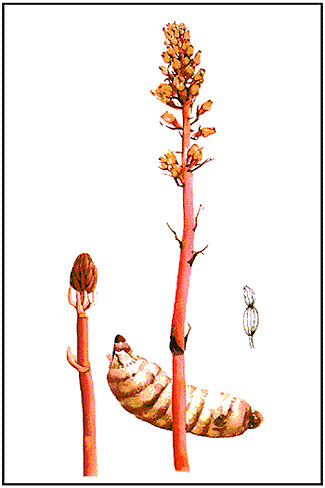
Gastrodia elata
GASTRODIA
Gastrodia refers to the tuber of an orchid, Gastrodia elata. This plant has an unusual requirement for survival: it must have the Armillaria mellea mushroom mycelia incorporated into the tuber in order to maintain its maturation and growth, and it requires another fungus, Mycena osmundicola, to sprout the seeds. When supplies of the crude gastrodia became rare in the 1970's, attempts at cultivating the herb repeatedly failed until this complex synergistic plant/mushroom relationship was determined. Then, cultivation became easy, though it was not until the late 1980's that an adequate cultivated supply of gastrodia was developed.
Interestingly, the medicinal benefits of gastrodia were found to be mainly the metabolites of the Armillaria mushroom. In other words, if one could grow the mushroom, the gastrodia tuber could be dispensed with and one could use just the mushroom material in place of gastrodia. This mushroom cultivation (by batch fermentation) was accomplished and the material was tested in the 1970's; today, gastrodia mushroom (Armillaria) is frequently used instead of cultivated gastrodia. In the meantime, wild gastrodia, along with all other wild orchids, has been put on the endangered species list.
Gastrodia was listed in the ancient Shennong Bencao Jing (ca. 100 A.D.) and was later classified by Tao Hong as a superior herb, meaning that it could be taken for a long time to protect the health and prolong life (as well as treating illnesses). It was originally called chiqian, meaning red arrow, because of its red stem shaped like an arrow. Later it was named tianma, or heavenly hemp (ma, usually translated as hemp, refers to many plants that have fibrous stems, such as the well-known mahuang).
The traditional use of gastrodia is to calm internal wind and dispel invading wind, and invigorate circulation in the meridians; thereby treating headache, dizziness, vertigo, convulsions, paralysis, and arthralgia. In the book Chinese English Manual of Commonly-Used Herbs in Traditional Chinese Medicine, the three basic indications are reduced to this elaborated pair:
According to research reports, the main active ingredients include gastrodin, a complex glycoside, plus vanillyl alcohol and vanillin, which, as their names suggest, are related to the flavor vanilla (vanilla comes from the fruit of another orchid, Vanilla planifolia, and the primary flavor is vanillin, which is synthetically produced as the standard flavor substitute). Vanillin has been shown to have anticonvulsive effects. There have been numerous other compounds identified in both Armillaria and the gastrodia tuber, with roles that are not yet established.
The gastrodia mushroom, Armillaria (also listed as Armillariella), is known in China as tianma mihuanjun. Like many other medicinal mushrooms, Armillaria contains immune-enhancing polysaccharides, but the amount of the gastrodia mushroom usually ingested is not sufficient to provide a substantial immune-enhancing action. Gram for gram, the armillaria mushroom is more potent than the gastrodia tuber, mainly because it is the primary source of the active constituents. An exact quantitative comparison has not been determined, and may vary with the different therapeutic applications, but, generally speaking, the dosage of armillaria to be used is about half that of gastrodia tuber. Because these products are safe to use, armillaria can be used in the same amount as the gastrodia rhizome it replaces in order to attain superior effects.
Gastrodia tuber is traditionally given in decoction in doses of 3.0-10.0 grams per day; the gastrodia mushroom (fermentation product) or gastrodia tuber is given in the form of a powder in doses of 1.0-1.5 each time, 2-3 times per day (total dosage of 2.0-4.5 grams/day).
According to Icones of Medicinal Fungi, Armillaria fermentation products "are found to produce satisfactory effect in treatment of dizziness caused by hypertension, insufficient blood supply to the arteries' cone base, Meniere's syndrome, as well as functional disorders in autonomic nervous system. They are also effective in improving numbed limbs, insomnia, tinnitus, epilepsy, vascular headache, and apoplectic sequela [post-stroke syndrome]."
The Advanced Textbook on Traditional Chinese Medicine and Pharmacology mentions that "This herb is mild, and can subdue hyperactive liver yang, eliminate wind, and remove obstruction in the collaterals, and is indicated for all kinds of wind syndromes, either cold or heat type or due to internal or external wind. For such cases, it is combined with other herbs according to the specific conditions. It is an important herb to treat dizziness." Examples of combining gastrodia with other herbs include these, from the Textbook:
April 1998

Gastrodia elata
Armillaria mellea